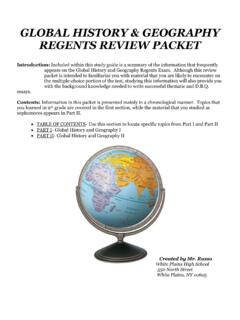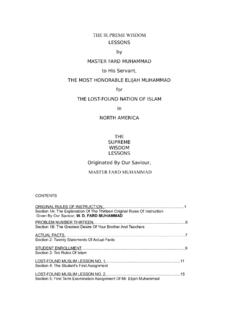Transcription of Chapter 3 World Religions 1. Introduction
1 Chapter 3 World Religions 1. Introduction By 500 , the roots of the World 's great religious traditions were emerging in the Middle East, India, and China. Judaism was well established in the Middle East, and later Christianity and islam developed there. Hinduism and Buddhism arose in India. And China developed Confucianism, a philosophy that became a state religion. All these Religions are unique, but they also have key elements in common. They all set down basic ethical principles to guide human actions. They use sacred texts to teach moral values, often through stories or parables. They offer a universal message that appealed to people in different places and with diverse cultural backgrounds. Click to read caption This broad appeal and emphasis on ethics made the new faiths different from earlier Religions . Previously, most Religions had been local, based on the worship of gods and spirits associated with particular places.
2 They involved rituals, such as animal sacrifice, that were designed to appease the gods and win their favor. People looked to the gods to help them in their daily lives, to bring prosperity and protect them from their enemies. 1. Chapter 3 World Religions In contrast, universal Religions look beyond this World and its practical needs. They offer the hope of a better life and access to a higher truth. Because these Religions are portable because they can be practiced anywhere they were able to spread to other parts of the World . In this way, they became World Religions . In this lesson, you will read about the six major World Religions . You will learn about their origins, basic beliefs, and practices. You will also see how they spread beyond their lands of origin to influence human society around the World . Themes Cultural Interaction Religions spread cultural ideas and also changed as they expanded around the World .
3 Their interaction with other cultures and belief systems was sometimes peaceful and sometimes not. Political Structures World Religions influenced rulers and political systems. Some religious institutions exercised great power. Economic Structures Some religious institutions amassed great wealth. An emphasis on charity helped people in need. Social Structures Religions influenced social systems such as families and schools. In some cases, they reinforced social classes. In others, they helped break down class barriers. 2. Judaism, Christianity, and islam The World Religions that arose in the Middle East Judaism, Christianity, and islam share some common traits. The most important is monotheism, the belief in a single, all-powerful God. They also believe in prophets, holy people who revealed the word of God. One important prophet in these Religions is Abraham, known as the father of the Jewish people.
4 Judaism: Origins and Development The early history of Judaism is shrouded in the mists of time. Most scholars believe, however, that Abraham was a real person who was born some 4,000 years ago in Mesopotamia. According to Jewish scripture, God visited Abraham one day and made a sacred agreement, or covenant, with him. Abraham promised that he and his descendants would follow God's teachings and God promised to love them. Abraham's descendants were known as the Israelites, sometimes called the Hebrews. They were the ancestors of the Jewish people. Click to read caption 2. Chapter 3 World Religions According to the Torah, Abraham and his family moved to Canaan, later called the Land of Israel, a region of land along the eastern coast of the Mediterranean Sea. His descendants later formed the twelve tribes of Israel. The tribes traveled to Egypt to escape a famine.
5 The Torah says that they were enslaved by the Egyptians for generations and that God performed miracles to free them. On the return from Egypt, the prophet Moses had a vision of God while praying at Mount Sinai. There, according to scripture, Moses revealed God's laws on stone tablets. These laws, which included the Ten Commandments, would form the basis of Judaism. The Israelites settled again in Canaan, which they regarded as their promised land. By 1000 , they established the Kingdom of Israel, led by kings who united the tribes of Israel. The second of these rulers, King David, made the city of Jerusalem the capital of the kingdom. His son, King Solomon, built the Temple, the most sacred place in Judaism, there. When Solomon died, in about 930 , the Kingdom of Israel separated into two kingdoms, Israel and Judah. Both were later invaded and conquered.
6 The kingdom of Israel was conquered in 722 by the Assyrians. In 597 , the Babylonians invaded Judah and attacked Jerusalem, then the capital of Judah. Jerusalem fell to the Babylonians in 586 Most of the people of Judah, now known as Jews, were forced into exile. The Babylonian Exile was the start of the Jewish Diaspora (die-AS-pur-ruh). From this time on, the Jewish people were dispersed across the Middle East and beyond. Other invaders, including the Romans, later occupied their land and caused more Jews to leave. Nevertheless, the Jewish religion survived. Jews both within the Land of Israel and throughout the Diaspora maintained strong connections to their homeland, stressing its importance and facing toward Jerusalem in their daily prayers. Jewish religious leaders called rabbis, which literally means teachers, were crucial to the survival of Judaism.
7 They preserved Jewish teachings and discussed ways to apply these teachings to new situations that Jews encountered. The early rabbis recorded Jewish traditions. This record eventually became the Talmud, which together with the Hebrew Bible forms the foundation of Jewish religious practice and ethical values. It includes some of Judaism's most famous quotes, such as What is hateful to you, do not do to your neighbor: that is the whole Torah; all the rest of it is commentary; go and study it.. Click to read caption 3. Chapter 3 World Religions The Beliefs of Judaism The central teachings of Judaism are contained in the Torah, which makes up the first five books of the Hebrew Bible. The Torah contains the Ten Commandments, along with other teachings handed down by God to Moses. The first commandment is central to Judaism. It says, You shall have no other gods before Me.
8 This law reminds Jews of their promise to worship only one God. Judaism transmitted the idea of monotheism to the rest of the World . It contrasted with the polytheism, or worship of many gods, which was typical of other Religions at the time. Another commandment requires Jews to set aside a holy day each week, called the Sabbath, for rest and prayer. This requirement later became a custom among Christians, too. Other commandments in the Torah lay down moral values. One says, Honor your father and mother. Others forbid stealing, lying, or murdering. The Torah says that Jews have a responsibility to live by God's moral teachings and make them known to the World . Judaism also stresses the importance of equality and social justice. It teaches that God considers all people equal and says that people should be treated fairly. One passage says, You shall open wide your hand to your brother, to the needy and to the poor.
9 Caring for less fortunate people in society is a basic value in Judaism. The Spread and Influence of Judaism The troubles faced by the Jews as a result of the Diaspora threatened their survival as a people. Cut off from their roots in Israel, they had to find ways to maintain their traditions in foreign lands. For example, praying together in synagogues became a central feature of Judaism. At times, the Jews faced great persecution for their customs and beliefs. Nevertheless, Jewish migration from Israel also helped spread the ideas of Judaism. Over the centuries, Jews settled in many parts of the Middle East, Europe, and Africa. They also made their way to Asia and, eventually, to the Americas. Although Judaism was not adopted widely among other cultures or peoples, Jews built strong communities around the World that helped preserve their culture and religion.
10 They continued religious practices, such as studying the Torah and observing the Sabbath, that helped keep Judaism alive. The teachings of Judaism have had a great impact on the World . The principle of monotheism influenced two other great religious traditions, Christianity and islam . Judaism's moral teachings and its idea of a weekly day of rest were also important influences. The emphasis on ethical conduct influenced the development of law in many lands. Jewish ideas of justice and equality also helped nurture the concept of democratic freedoms. Click to read caption 4. Chapter 3 World Religions Christianity: Origins and Development The second World religion to emerge in the Middle East was Christianity. The birthplace of Christianity was a territory at the eastern end of the Mediterranean Sea. The Romans called it Judea. It had once been a part of the ancient Kingdom of Israel.















